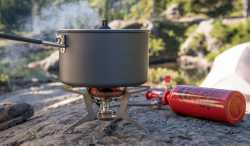>>2797540I've got an old one (1950s Turm 144, basically a Wehrmacht cooker except that they changed the tank from brass to steel after the war).
The main downside is that youcan't adjust these stoves properly. Where on a gas stove, the pressure is nearly constant (in the beginning, at least) due to the gas trying to evaporate, on liquid stoves, the pressure is built up by running the fuel hose through the flame. Close the valve, and the fuel will stay over the flame longer, build up more pressure, and pass through the valve faster, so you don't see much effect.
However, that's also the main advantage: where gas stoves can "freeze" and stop running just from the gas inside the bottle getting colder through it's own evaporation, a liquid stove will heat itsself and keep running as long as the fuel doesn't literally freeze.
For fuel, it depends on the stove, specifically, the nozzle. Most stoves can do petroleum (safe, but will freeze at really cold temps) and gasoline (won't freeze, but has some risk of explosions), often on he same nozzle, some (like my Turm) are built for alcohol. Alcohol combines the disadvantages of petroleum (freezes in extreme cold) and gasoline (can explode if you don't know what you're doing), so I wouldn't recommend it. For me, the stove is mostly for disaster preparedness, since I can get large amounts of methanol from the distilleries around here.

